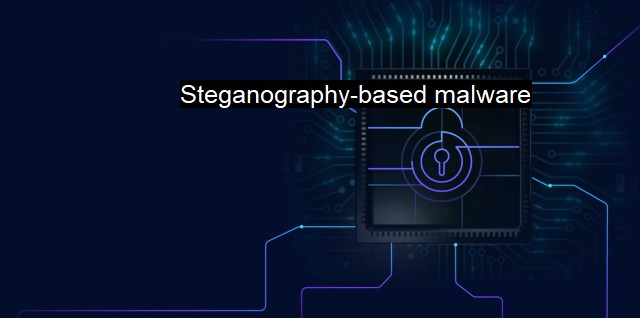What is Steganography-based malware?
The Rise of Steganography: Hidden Malware Attacks Using Sophisticated Cloaking Techniques
Steganography-based malware has become a major concern in the field of cybersecurity. Steganography, a Greek term that translates to "covered writing", has been practised for centuries as a means of hiding secret messages within different forms of media, primarily text. While this method of secretive communication has been used for purposes as benign as fun and games, in the advanced, technology-imbued world of today, steganography has found more sinister applications. Cyber criminals adopted this method to discreetly cover their malicious activities, leading to what we now call "Steganography-based malware".Steganography-based malware is a sophisticated form of cyberattack in which digital stenography is used as a means of hiding, transferring and executing malicious software or 'malware'. What makes such types of attacks immensely challenging to detect is how unsuspectingly regular file formats and channels of digital communication can be employed. Cyber attackers hide the malware in images, audio files, video files, text and other usual types of data formats, ensuring the malware remains undetected while in transit or even when the carrying file is in plain sight.
To understand how profoundly inconspicuous steganography-based malware is, one must focus on its underlying methodology. Traditional malware uses encryption to obscure the malicious content, making it difficult for cybersecurity defenses to intercept and identify the threat. for encryption-based malware, monitoring the network traffic for encrypted connections could be an effective way of detecting it. On the contrary, steganography-based malware uses a different technique. The malware is hidden in the Metadata or the payload of conventional files by adjusting minute pieces of data called 'bits'. Since the changes to the carrier file are often virtually undetectable without deciphering tools or a comprehensive image analysis or savvy decoding, the malicious activity remains concealed.
The implications of steganography-based malware in the digital space are colossal. This type of cyberattack comes under the category of advanced persistent threats (APTs), which are prolonged and targeted cyberattacks where an intruder gains access to a network and remains unidentified for an elongated period. One of the gravest forms of cyber espionage, these are often the workings of state-sponsored cyber-criminal organisations or groups with the 'patience' of performing slow but highly destructive infiltration.
This evolved approach to cyber intrusion and data theft makes antivirus technologies struggle while recognizing and countering these subliminal threats accurately. As cyber-attackers continue to evolve and refine their techniques, cybersecurity and antivirus must persistently innovate and enhance their defensive and corrective measures. Conventional antivirus methods based on virus-signature matching prove woefully inadequate against steganography-based malware, requiring more dynamic technologies for anomaly detection, including Artificial Intelligence and Machine Learning.
AI can be employed to identify minor alterations in files indicative of steganographic methods, while ML algorithms can be used to isolate deviations from 'normal' files, thereby accurately detecting the presence of steganography-based malware. deep packet inspection that analyses the data part and the header of the transmitted packets traversing the network can expose abnormalities, potentially signifying a steganography-based malware attack.
Steganography-based malware is not only a highly compelling method for attackers to embed malicious components in regular files, but it also ranks among the toughest cyber threats to detect and combat. As cybersecurity threats continue to morph and scale unprecedentedly, reactively defending against these advanced threats is not enough. Proactively innovating defensive mechanisms, according to the changing attack-environment, is now of paramount importance in cybersecurity. Therefore, the focus lies in discovering, building, and employing cutting-edge technologies and methods, such as intelligence-driven defense solutions and anomaly detection models, to facilitate detection of steganography-based malware, therein ensuring the strengthening of cybersecurity defenses across the globe.

Steganography-based malware FAQs
What is steganography-based malware?
Steganography-based malware is a type of malicious software that uses steganography techniques to hide its existence or malicious payload within innocent files such as images, audio, or video. This technique allows the malware to evade traditional antivirus detection systems that rely on signature or behavior-based analysis.How does steganography-based malware work?
Steganography-based malware works by embedding its code or payload within the cover file's data, which can be an image, audio, or video file. The malware then modifies the least significant bits of the data to store its malicious code, which is usually encrypted. When the cover file is opened by a user or system, the malware extracts its payload from the modified data and executes it.What are the risks associated with steganography-based malware?
Steganography-based malware can pose significant risks to computer systems and users. They can carry out various malicious activities, such as stealing sensitive data, monitoring the user's activities, installing backdoors, or downloading additional malware. Moreover, steganography-based malware can evade detection by traditional antivirus software, making it challenging to detect and remove.How can we protect against steganography-based malware?
To protect against steganography-based malware, it's crucial to use advanced cybersecurity solutions that employ heuristic or machine learning-based detection techniques. These systems can detect anomalies in the file structure, size, or data that may indicate the presence of steganography-based malware. Additionally, users can avoid downloading files from suspicious websites or opening attachments from unknown senders to prevent malware infection.| | A | | | B | | | C | | | D | | | E | | | F | | | G | | | H | | | I | | | J | | | K | | | L | | | M | |
| | N | | | O | | | P | | | Q | | | R | | | S | | | T | | | U | | | V | | | W | | | X | | | Y | | | Z | |
| | 1 | | | 2 | | | 3 | | | 4 | | | 7 | | | 8 | | |||||||